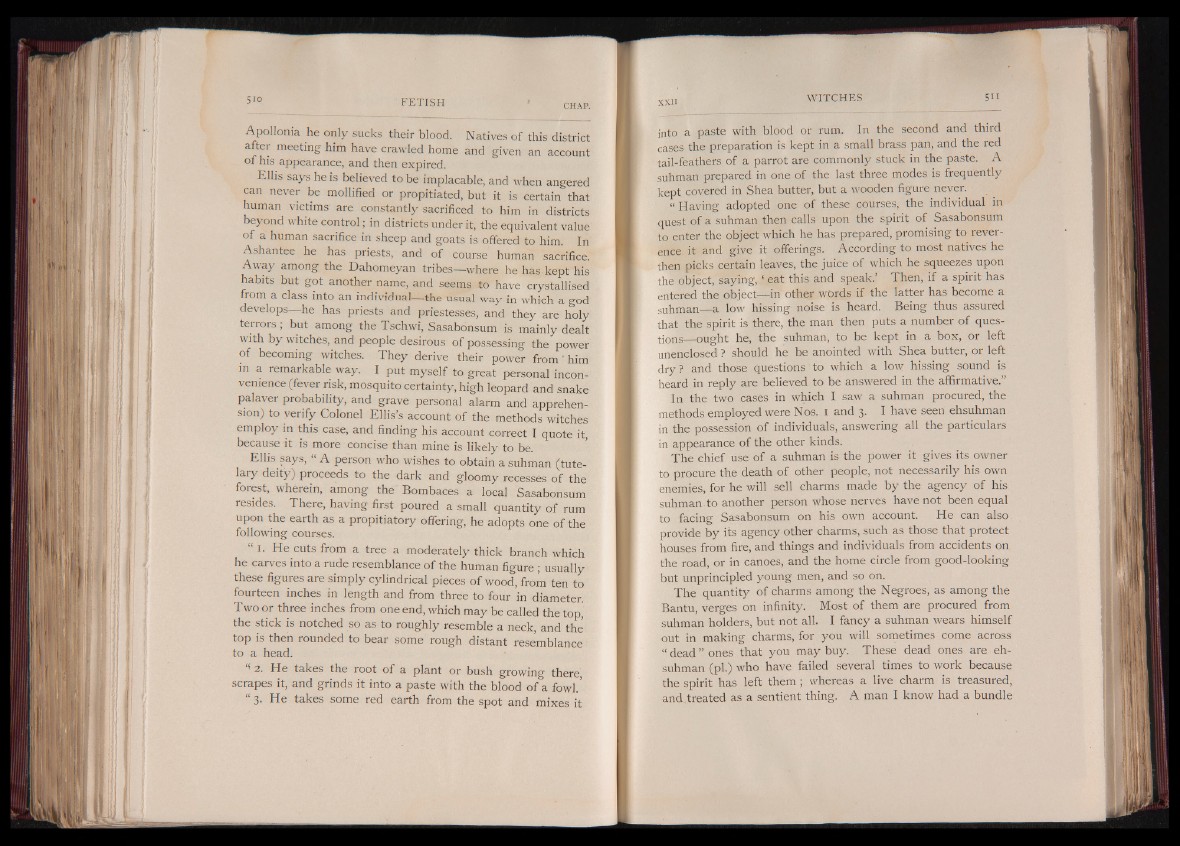
Apollonia he only sucks their blood. Natives of this district
after meeting him have crawled home and given an account
of his appearance, and then expired.
Ellis says he is believed to be implacable, and when angered
can never be mollified or propitiated, but it is certain that
human victims are constantly sacrificed to him in districts
beyond white control; in districts under it, the equivalent value
of a human sacrifice in sheep and goats is offered to him. In
Ashantee he has priests, and of course human sacrifice.
Away among the Dahomeyan tribes— where he has kept his
habits but got another name, and seems to have crystallised
from a class into an individual— the usual way in which a god
develops— he has priests and priestesses, and they are holy
terrors; but among the Tschwi, Sasabonsum is mainly dealt
with by witches, and people desirous of possessing the power
of becoming witches. They derive their power from'him
in a remarkable way. I put myself to great personal inconvenience
(fever risk, mosquito certainty, high leopard and snake
palaver probability, and grave personal alarm and apprehension)
to verify Colonel Ellis’s account of the methods witches
employ in this case, and finding his account correct I quote it,
because it is more concise than mine is likely to be.
Ellis says, ‘ A person who wishes to obtain a suhman (tutelary
deity) proceeds to the dark and gloomy recesses of the
forest, wherein, among the Bombaces a local Sasabonsum
resides. There, having first poured a small quantity of rum
upon the earth as a propitiatory offering, he adopts one of the
following courses.
[. He cuts from a tree a moderately thick branch which
he carves into a rude resemblance of the human figure ; usually
these figures are simply cylindrical pieces of wood, from ten to
fourteen inches in length and from three to four in diameter.
Two or three inches from one end, which may be called the top,
the stick is notched so as to roughly resemble a neck, and the
top is then rounded to bear some rough distant resemblance
to a head.
* 2. He takes the root of a plant or bush growing there
scrapes it, and grinds it into a paste with the blood of a fowl.’
3* He takes some red earth from the spot and mixes it
into a paste with blood or rum. In the second and third
cases the preparation is kept in a small brass pan, and the red
tail-feathers of a parrot are commonly stuck in the paste. A
suhman prepared in one of the last three modes is frequently
kept covered in Shea butter, but a wooden figure never.
“ Having adopted one of these courses, the individual in
quest of a suhman then calls upon the spirit of Sasabonsum
to enter the object which he has prepared, promising to reverence
it and give it offerings. According to most natives he
then picks certain leaves, the juice of which he squeezes upon
the object, saying, ‘ eat this and speak.’ Then, if a spirit has
entered the object— in other words if the latter has become a
suhman— a low hissing noise is heard. Being thus assured
that the spirit is there, the man then puts a number of questions—
ought he, the suhman, to be kept in a box, or left
unenclosed ? should he be anointed with Shea butter, or left
dry ? and those questions to which a low hissing sound is
heard in reply are believed to be answered in the affirmative.”
In the two cases in which I saw a suhman procured, the
methods employed were Nos. i and 3. I have seen ehsuhman
in the possession of individuals, answering all the particulars
in appearance of the other kinds.
The chief use of a suhman is the power it gives its owner
to procure the death of other people, not necessarily his own
enemies, for he will sell charms made by the agency of his
suhman to another person whose nerves have not been equal
to facing Sasabonsum on his own account. He can also
provide by its agency other charms, such as those that protect
houses from fire, and things and individuals from accidents on
the road, or in canoes, and the home circle from good-looking
but unprincipled young men, and so on.
The quantity of charms among the Negroes, as among the
Bantu, verges on infinity. Most of them are procured from
suhman holders, but not all. I fancy a suhman wears himself
out in making charms, for you will sometimes come across
“ dead ” ones that you may buy. These dead ones are ehsuhman
(pi.) who have failed several times to work because
the spirit has left them; whereas a live charm is treasured,
and ,treated as a sentient thing. A man I know had a bundle